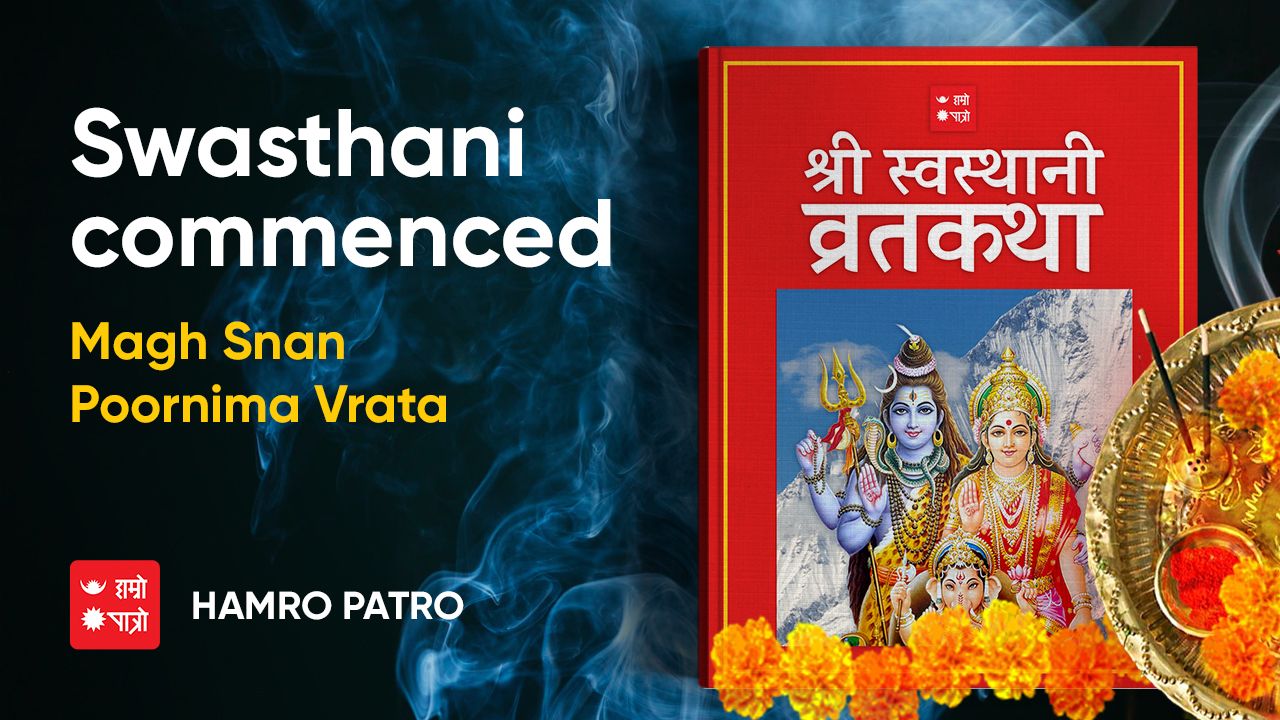
The 31 chapters of Swasthani Maha Purana
The 31 chapters of Swasthani Bratakatha, which started on Poush Shukla Purnima, will end on Magh Shukla Purnima next month. Men and women alike can fast for a month by listening to this story in the same way. In this way, one satvik meal is eaten and fruits as other meal.
Swasthani: One among 8 asthamarikas of Satana philosophy
From today, many families abstain from fish and meat, may the welfare of all be ensured in this special month of Shri Swasthani Mata. The story begins with the mantra 'Yan Brahma Varunerudramarut' and ends with the hymn 'Upanayatu Mangalam'.
The glory of Swasthani mother, who lives among the eight goddesses, is very significant. Swasthani has four hands and in her hands are the chakra, Trishul, sword, and lotus flower.
It is important to link the Vedic Sanatan rites with civilization rather than religion. There is evidence and documents that Sindhu was Hindu by using the word 'H' instead of 'S' as there is no easy availability and easy pronunciation of the word 'S' in the Farsi language. Thus, the civilization on the banks of the river Indus happened.
These Ashta Matrikas are very important in Nepali life, as the eight knots of our Daura Suruwal are taken as a symbol of these Ashta Matrikas, we all know that the eight numbers are taken as auspicious numbers.
Swasthani Mata as the center of the Asthamatrikas
Vaishnavi, Mahakali, Chamunda, Indrani, Varahi, Komari, Maheshwari and Brahmi Mata forms are seated as Ashmatrika.
According to the book 'Vrihadsvasthani-Vratkatha', Srisvasthani Devi has 8 forms, which are called Ashtadals. Sitting in the center of the octagon is the goddess Srisvasthani holding a trishul, a sword, a chakra and a lotus in her four hands.
Who narrates the Swasthani Purana?
In the Vedic Sanatan Hindu rites, most of the Puranas are recited by one character as the narrator.
The Bhagavad Gita is a dialogue between Krishna and Arjuna, while the Swasthani Vratakatha is a dialogue between Shivaji's eldest son Kumarji and Agastyamuni.
From today, the Shali River in Sakhu, Kathmandu will be flooded, but this year, due to the Corona terror, there has been a decrease in the number of pilgrimages and crowds. The power of Goddess Swasthani is evident when one sees the courage and faith of those who return in the middle of winter and dive into the cold river water with reverence and faith.
The story of Goma Brahmani has spread public awareness about child marriage by presenting the bad effects of child marriage even in ancient times. Explaining sexual and reproductive health with examples, the story also advocates for gender equality between men and women in many places through Ganesha's beheading, the creation of the world, and the relationship between Shiva and Parvati.
May the banks of the rivers worshiped in winter protect everyone in the rain, may the waves of sexual equality spread in the society in real life, may the Ashta Matrikas, including Mata Swasthani, have immense compassion for us. Hail, Swasthani!
Magh bathing ritual started/ Magh Snan Suru
Although it is difficult to take a heavy bath in the winter month of Magh, bathing with reverence only on the first day, i.e. the day of the full moon, can become the heir of heaven. According to the resolution of Magh Snan and Prarambha Shastra, Swasthani Bratakatha should be taken from the day of the full moon.
Donations have a special significance in January. Sesame, Chaku, ghee, and blankets are considered as special virtues in charity.
Bathing in the holy rivers in the month of Magh gives one special energy. Similarly, it is described in the scriptures and Puranas that bathing, charity, religion, virtue, worship, and devotion in the month of Magh, all kinds of happiness can be obtained and in the end, Lord Narayana can be achieved.
Poornima Vrata
The last day of Shukla Paksha is the full moon day. Today is the Poush Poornima, a poornima which officially commences the Swathani vrat katha. On this tithi, the moon is the brightest and magnificent. It is believed that fasting on this day brings immense lunar grace to health, prosperity, and peace. On the full moon day, Lord Shiva and Vishnu are especially worshiped. Special worship to Lord Vishnu is done in the form of Satya Narayan Puja. Satya Narayan Puja is usually performed whenever possible, although the fruits of this puja performed on the day of the full moon are very abundant.
From a scientific point of view, it is said that gravity will have a great effect on the earth on the day of the full moon and self-purification will be done by fasting on this day and remembering the name of God. By fasting on this day, the metabolic process will be strengthened, gastric problems will be solved and positive energy will increase in the body.
This day is fasted from sunrise in the morning to moonrise in the evening. Some people observe this fast without drinking water, while others observe this fast by eating only one meal and eating no salt (alino) food. In the evening, after the moonrise, the fast ends with the sighting of the moon. Happy Jestha Shukla Purnima to everyone this year.
Let there be the protection of both religion and the followers of religion.
Suyog Dhakal
Liked by: